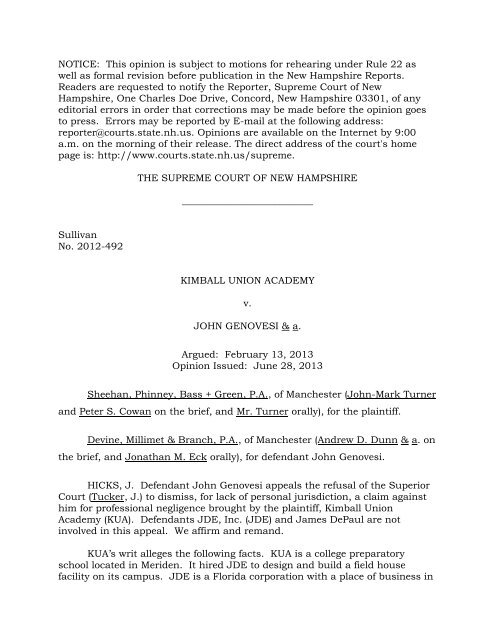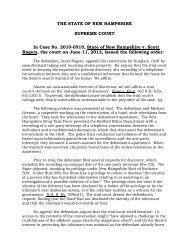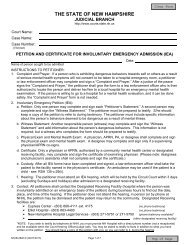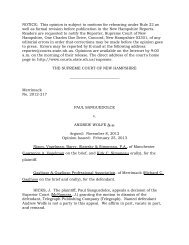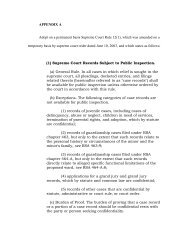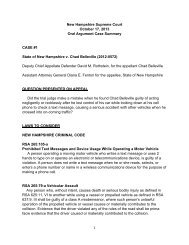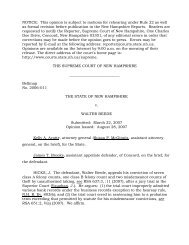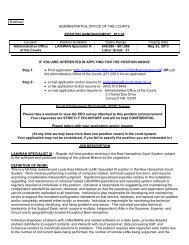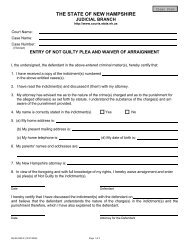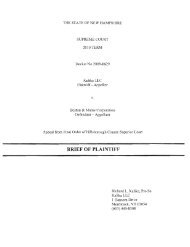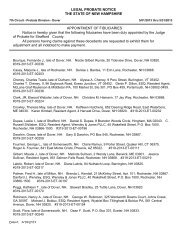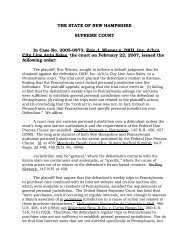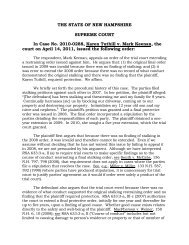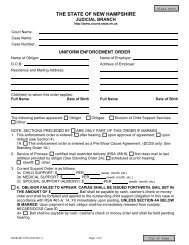2012-492, Kimball Union Academy v. John Genovesi & a. - New ...
2012-492, Kimball Union Academy v. John Genovesi & a. - New ...
2012-492, Kimball Union Academy v. John Genovesi & a. - New ...
You also want an ePaper? Increase the reach of your titles
YUMPU automatically turns print PDFs into web optimized ePapers that Google loves.
NOTICE: This opinion is subject to motions for rehearing under Rule 22 as<br />
well as formal revision before publication in the <strong>New</strong> Hampshire Reports.<br />
Readers are requested to notify the Reporter, Supreme Court of <strong>New</strong><br />
Hampshire, One Charles Doe Drive, Concord, <strong>New</strong> Hampshire 03301, of any<br />
editorial errors in order that corrections may be made before the opinion goes<br />
to press. Errors may be reported by E-mail at the following address:<br />
reporter@courts.state.nh.us. Opinions are available on the Internet by 9:00<br />
a.m. on the morning of their release. The direct address of the court's home<br />
page is: http://www.courts.state.nh.us/supreme.<br />
THE SUPREME COURT OF NEW HAMPSHIRE<br />
___________________________<br />
Sullivan<br />
No. <strong>2012</strong>-<strong>492</strong><br />
KIMBALL UNION ACADEMY<br />
v.<br />
JOHN GENOVESI & a.<br />
Argued: February 13, 2013<br />
Opinion Issued: June 28, 2013<br />
Sheehan, Phinney, Bass + Green, P.A., of Manchester (<strong>John</strong>-Mark Turner<br />
and Peter S. Cowan on the brief, and Mr. Turner orally), for the plaintiff.<br />
Devine, Millimet & Branch, P.A., of Manchester (Andrew D. Dunn & a. on<br />
the brief, and Jonathan M. Eck orally), for defendant <strong>John</strong> <strong>Genovesi</strong>.<br />
HICKS, J. Defendant <strong>John</strong> <strong>Genovesi</strong> appeals the refusal of the Superior<br />
Court (Tucker, J.) to dismiss, for lack of personal jurisdiction, a claim against<br />
him for professional negligence brought by the plaintiff, <strong>Kimball</strong> <strong>Union</strong><br />
<strong>Academy</strong> (KUA). Defendants JDE, Inc. (JDE) and James DePaul are not<br />
involved in this appeal. We affirm and remand.<br />
KUA’s writ alleges the following facts. KUA is a college preparatory<br />
school located in Meriden. It hired JDE to design and build a field house<br />
facility on its campus. JDE is a Florida corporation with a place of business in
Pennsylvania. James DePaul is JDE’s president and resides in Pennsylvania.<br />
Under its contract with KUA, JDE was required to supply an architect and an<br />
engineer, both licensed in <strong>New</strong> Hampshire, for the project’s design.<br />
The writ further alleges that <strong>Genovesi</strong> is a professional engineer who<br />
resides in <strong>New</strong> Jersey. He is not licensed in <strong>New</strong> Hampshire. Nevertheless,<br />
JDE hired him “to perform certain design work for the footings and foundation<br />
system” of the field house. JDE and <strong>Genovesi</strong> failed to “prepare a complete set<br />
of construction documents, for the footing and foundation system design,”<br />
prior to the commencement of work on the footings and foundation. The<br />
incomplete design “lacked key information essential to the construction and<br />
proper inspection of the footings and foundation system. Among other things,<br />
[<strong>Genovesi</strong>] failed to provide (or to determine that others were providing) special<br />
inspection instructions for the footings and foundation system as required by<br />
the” applicable building code.<br />
KUA’s writ alleges a number of problems with the footing and foundation<br />
work that prompted it to terminate its contract with JDE and commence this<br />
action. The writ alleges a single count, for professional negligence, against<br />
<strong>Genovesi</strong>, which reads, in part, as follows:<br />
[<strong>Genovesi</strong>] breached his duty to KUA by failing to perform<br />
his work on the Project in conformance with both the applicable<br />
laws and codes and with the applicable professional practice<br />
standards governing his work by, among other things, failing to<br />
prepare complete construction documents and failing to supply<br />
special inspection instructions for the footing and foundation<br />
work and/or to determine that such special inspection<br />
instructions were provided.<br />
<strong>Genovesi</strong> moved to dismiss, asserting that the superior court lacks<br />
personal jurisdiction over him. He submitted an affidavit averring that he has<br />
“never resided in <strong>New</strong> Hampshire, owned any real property in <strong>New</strong> Hampshire,<br />
advertised in <strong>New</strong> Hampshire, had any business interests in <strong>New</strong> Hampshire,<br />
or even been in <strong>New</strong> Hampshire since a ski vacation . . . more than thirty years<br />
before the circumstances of this case arose.” He also averred that he “did all of<br />
the work in connection with preparing foundation drawings from [his] office in<br />
<strong>New</strong> Jersey.” KUA objected, submitting, among other things, copies of the<br />
contract between <strong>Genovesi</strong> and JDE, <strong>Genovesi</strong>’s bill for services, which reflects<br />
three conference calls with <strong>New</strong> Hampshire participants, and certain e-mails.<br />
The trial court denied <strong>Genovesi</strong>’s request for an evidentiary hearing and denied<br />
his motion to dismiss. This appeal followed.<br />
Our standard of review for rulings on motions to dismiss for lack of<br />
personal jurisdiction varies according to the case’s procedural posture. State v.<br />
2
N. Atlantic Ref. Ltd., 160 N.H. 275, 280 (2010). “When, as in this case, the<br />
trial court rules upon the motion without holding an evidentiary hearing, the<br />
trial court employs a prima facie standard, and we review the trial court’s<br />
decision de novo.” Id. (quotation omitted). The inquiry under the prima facie<br />
standard is whether the plaintiff “has proffered evidence which, if credited, is<br />
sufficient to support findings of all facts essential to personal jurisdiction.” Id.<br />
(quotation omitted). “[T]he plaintiff ordinarily cannot rest upon the pleadings,<br />
but is obliged to adduce evidence of specific facts.” Id. at 281 (quotation<br />
omitted). Both the trial court and we, when undertaking de novo review, “must<br />
accept the plaintiff’s (properly documented) proffers as true for the purpose of<br />
determining the adequacy of the prima facie jurisdictional showing.” Id.<br />
(quotation omitted). The plaintiff’s evidentiary proffers must be construed “in<br />
the light most congenial to the plaintiff’s jurisdictional claim” and “[f]acts put<br />
forward by the defendant may be considered only if they are uncontradicted by<br />
the plaintiff’s submissions.” Id. (quotation omitted).<br />
<strong>Genovesi</strong> first argues that the trial court erred in failing to conduct an<br />
analysis under <strong>New</strong> Hampshire’s long-arm statute. See RSA 510:4, I (2010).<br />
“To decide whether it may exercise in personam jurisdiction over a nonresident<br />
defendant, a court typically must engage in a two-part inquiry. First,<br />
the State’s long-arm statute must authorize such jurisdiction. Second, the<br />
requirements of the federal Due Process Clause must be satisfied.” Fellows v.<br />
Colburn, 162 N.H. 685, 690 (2011) (quotation and citation omitted).<br />
<strong>Genovesi</strong> acknowledges our case law construing the <strong>New</strong> Hampshire<br />
long-arm statute to permit “the exercise of jurisdiction to the extent permissible<br />
under the Federal Due Process Clause,” id., but asserts that this interpretation<br />
“does not permit a trial court to conflate the analyses in circumstances where<br />
the plain language of the statutory requirements have not been met.” We are<br />
not persuaded. “Because we construe the long-arm statute broadly, personal<br />
jurisdiction over nonresidents may be exercised whenever the requirements of<br />
the Due Process Clause of the United States Constitution are satisfied.”<br />
Alacron v. Swanson, 145 N.H. 625, 628 (2000) (citation omitted). Moreover, we<br />
disagree that <strong>Genovesi</strong> does not fall within the statute’s plain language.<br />
<strong>New</strong> Hampshire’s long-arm statute provides, in part:<br />
Any person who is not an inhabitant of this state and who, in<br />
person or through an agent, transacts any business within this<br />
state, [or] commits a tortious act within this state . . . submits<br />
himself, or his personal representative, to the jurisdiction of the<br />
courts of this state as to any cause of action arising from or<br />
growing out of the acts enumerated above.<br />
3
RSA 510:4, I. <strong>Genovesi</strong> contends that he did not transact any business in this<br />
state, given that it is undisputed that his business transactions were with JDE,<br />
a Florida corporation, and DePaul, a Pennsylvania resident. He also asserts<br />
that he did not commit a tortious act in <strong>New</strong> Hampshire, “as he completed all<br />
of his work from his office in <strong>New</strong> Jersey.”<br />
KUA counters that the long-arm statute is satisfied because <strong>Genovesi</strong>’s<br />
tortious act caused injury in <strong>New</strong> Hampshire. We agree. “For jurisdictional<br />
purposes, a party commits a tortious act within the State when the injury<br />
occurs in <strong>New</strong> Hampshire even if the injury is the result of acts outside the<br />
State.” Thomas v. Telegraph Publ’g Co., 151 N.H. 435, 437 (2004); see<br />
Tavoularis v. Womer, 123 N.H. 423, 426 (1983) (holding that “the fact that only<br />
the alleged injury occurred within the State does not preclude <strong>New</strong> Hampshire<br />
courts from subjecting a nonresident to their jurisdiction under the long-arm<br />
statute”).<br />
<strong>Genovesi</strong> argues, however, that KUA has “failed to allege an injury which<br />
can be causally related to the alleged negligent actions taken by [him]” because<br />
it “does not allege that [his] designs were actually used by JDE to complete the<br />
KUA field house.” In fact, <strong>Genovesi</strong> points out, KUA’s writ alleges that “[t]he<br />
footing and foundation work performed by JDE did not conform to the design<br />
prepared by [<strong>Genovesi</strong>].” Thus, <strong>Genovesi</strong> argues, his designs could not have<br />
caused injury in <strong>New</strong> Hampshire even assuming they were negligently<br />
prepared.<br />
<strong>Genovesi</strong>’s argument is unavailing. First, as KUA notes, its writ alleges<br />
that “[t]he footing and foundation system design prepared by [<strong>Genovesi</strong>] and<br />
used by JDE was incomplete and lacked key information.” (Emphasis added.)<br />
Moreover, that KUA’s writ alleges JDE negligently executed <strong>Genovesi</strong>’s design<br />
does not negate its allegation that the design itself was also negligently<br />
prepared by <strong>Genovesi</strong>. Any issue related to the actual causation of injury is, as<br />
KUA suggests, a merits issue rather than a jurisdictional one. For similar<br />
reasons, we are not persuaded by <strong>Genovesi</strong>’s argument that “JDE was<br />
supposed to present Mr. <strong>Genovesi</strong>’s foundation design to a <strong>New</strong> Hampshirelicensed<br />
professional engineer for review, signature, and seal by that<br />
engineering professional prior to submission to the [town] for a building<br />
permit.” Again, this fact, even if true, does not negate the allegation that<br />
<strong>Genovesi</strong> was negligent in the first instance. Issues of ultimate responsibility<br />
are not before us. We conclude that because <strong>Genovesi</strong> is alleged to have<br />
caused injury in <strong>New</strong> Hampshire by his tortious acts, the requirements of <strong>New</strong><br />
Hampshire’s long-arm statute have been met. See Thomas, 151 N.H. at 437.<br />
We now turn to the second prong of the jurisdictional inquiry – whether<br />
the requirements of the Federal Due Process Clause are satisfied. See Fellows,<br />
162 N.H. at 690. Under the Federal Due Process Clause, “a court may exercise<br />
4
personal jurisdiction over a non-resident defendant if the defendant has<br />
minimum contacts with the forum, such that the maintenance of the suit does<br />
not offend traditional notions of fair play and substantial justice.” Id. at 690-<br />
91 (quotation omitted). KUA does not contend that <strong>Genovesi</strong> has the<br />
“continuous and systematic” contacts with <strong>New</strong> Hampshire to support general<br />
jurisdiction; rather, the issue is whether KUA has demonstrated specific<br />
jurisdiction, “where the cause of action arises out of or relates to the<br />
defendant’s forum-based contacts.” Id. at 691.<br />
In determining whether the exercise of specific personal<br />
jurisdiction over a defendant comports with due process, we<br />
examine whether: (1) the contacts relate to the cause of action;<br />
(2) the defendant has purposefully availed [himself] of the<br />
protection of <strong>New</strong> Hampshire’s laws; and (3) it would be fair and<br />
reasonable to require the defendant to defend the suit in <strong>New</strong><br />
Hampshire. Each factor must be evaluated on a case-by-case<br />
basis, and all three factors must be satisfied in order for the<br />
exercise of jurisdiction to be constitutional.<br />
Id. (citation omitted).<br />
<strong>Genovesi</strong> asserts that neither the first nor second factor is met here.<br />
“The first inquiry, relatedness, asks whether the claim underlying the litigation<br />
directly arises out of, or relates to, the defendant’s forum-state activities.”<br />
Astro-Med, Inc. v. Nihon Kohden America, Inc., 591 F.3d 1, 9 (1st Cir. 2009)<br />
(quotations, brackets, and ellipsis omitted). The test for relatedness is a<br />
“flexible, relaxed standard.” Id. (quotations omitted). “To satisfy the<br />
relatedness factor, there must be more than just an attenuated connection<br />
between the contacts and the claim; the defendant’s in-state conduct must<br />
form an important, or at least material, element of proof in the plaintiff’s case.”<br />
N. Atlantic Ref. Ltd., 160 N.H. at 282 (quotation and brackets omitted).<br />
<strong>Genovesi</strong> argues that the trial court erred in finding sufficient minimum<br />
contacts in the form of three telephone conferences and one e-mail he directed<br />
into <strong>New</strong> Hampshire where “KUA does not allege that [he] committed any tort<br />
through his e-mail or during [those] telephone communications” and his “email<br />
and telephone contacts with <strong>New</strong> Hampshire do not form an element of<br />
proof, material or otherwise, necessary to establish KUA’s cause of action<br />
against [him] for professional negligence.” Rather, he contends, KUA alleges<br />
negligence in the preparation of design work that he: (1) “contracted<br />
exclusively with JDE, a non-<strong>New</strong> Hampshire entity, to prepare”; (2) completed<br />
at his office in <strong>New</strong> Jersey; and (3) submitted to DePaul in Pennsylvania by e-<br />
mail.<br />
5
<strong>Genovesi</strong>’s argument, however, like that of the defendant in Astro-Med,<br />
“emphasizes too fine a point.” Astro-Med, 591 F.3d at 10. “[A] defendant need<br />
not be physically present in the forum state to cause injury (and thus “activity”<br />
for jurisdictional purposes) in the forum state.” Id. (quotation omitted).<br />
<strong>Genovesi</strong>’s allegedly negligent design work in <strong>New</strong> Jersey led to the injury to<br />
KUA in <strong>New</strong> Hampshire. “That in-forum injury was clearly related to” KUA’s<br />
professional negligence claim. Id.<br />
Moreover, that the injury would occur in <strong>New</strong> Hampshire was entirely<br />
foreseeable. See N. Atlantic Ref. Ltd., 160 N.H. at 282 (noting that “[t]he<br />
court’s assessment of relatedness is informed by the concept of foreseeability”)<br />
(quotation omitted)). The proffered evidence shows that <strong>Genovesi</strong> gave JDE a<br />
“proposal for engineering services to provide a foundation design for the 160’ x<br />
250’ KUA Field House.” The proposal referenced the project’s address in <strong>New</strong><br />
Hampshire. <strong>Genovesi</strong> was therefore aware that his plans would be utilized in<br />
constructing a building in <strong>New</strong> Hampshire.<br />
Furthermore, the trial court noted that “<strong>Genovesi</strong> actively engaged in<br />
making his work suitable to its location in <strong>New</strong> Hampshire, mindful of local<br />
restrictions and in coordination with local specialists.” For instance, in an e-<br />
mail to DePaul, <strong>Genovesi</strong> stated that he “spoke with Richard Porter of<br />
Engineered Foundation Technologies [in Nashua] at some length regarding the<br />
site conditions” and that he would “proceed with the foundation design along<br />
th[e] line” they discussed. The trial court concluded that “[a]n integral part of<br />
<strong>Genovesi</strong>’s work was the location of the Project, and <strong>Genovesi</strong> maintained<br />
extensive contacts with <strong>New</strong> Hampshire in order to make his design fit the<br />
specifications of that location.” We find no error in the court’s determination<br />
that <strong>Genovesi</strong>’s <strong>New</strong> Hampshire contacts related to KUA’s cause of action.<br />
The second factor asks whether “the defendant has purposefully availed<br />
[himself] of the protection of <strong>New</strong> Hampshire’s laws.” Fellows, 162 N.H. at 691.<br />
Purposeful availment requires both foreseeability and<br />
voluntariness. Voluntariness requires that the defendant’s<br />
contacts with the forum state proximately result from actions<br />
by the defendant himself. The contacts must be deliberate, and<br />
not based on the unilateral actions of another party.<br />
Foreseeability requires that the contacts also must be of a<br />
nature that the defendant could reasonably anticipate being<br />
haled into court there.<br />
N. Atlantic Ref. Ltd., 160 N.H. at 284 (quotations and citations omitted).<br />
<strong>Genovesi</strong> maintains that he, “by his own acts, sought to contract with<br />
JDE and agreed to design a foundation from <strong>New</strong> Jersey pursuant to<br />
6
specifications submitted by JDE.” <strong>Genovesi</strong> knew, however, that his design<br />
would be used to construct a building in <strong>New</strong> Hampshire. As noted above, his<br />
proposal to JDE referenced the field house facility’s address in <strong>New</strong> Hampshire.<br />
The scope of the proposed work included “[d]etermin[ing] local environmental<br />
loads in accordance with State, County and Town building codes.” It also<br />
proposed the “[r]eview [of] geotechnical report test data and recommendations”<br />
and promised that “[d]rawings will be complete and ready for review and<br />
signature by a local professional for submission to the [town] for a building<br />
permit.” The use of the allegedly negligent design in <strong>New</strong> Hampshire cannot be<br />
said to constitute “unilateral action[ ]” by JDE that would render <strong>Genovesi</strong>’s<br />
contact with <strong>New</strong> Hampshire involuntary. Id. (quotation omitted). Moreover,<br />
because <strong>Genovesi</strong> “purposefully entered into a contract [with JDE] which had<br />
substantial connections with <strong>New</strong> Hampshire, . . . [he] could reasonably<br />
anticipate being haled into court here.” Computac, 124 N.H. at 354. It was<br />
foreseeable that any injury that would result from negligent preparation of the<br />
foundation design would occur in <strong>New</strong> Hampshire, where the foundation was<br />
constructed, and that suit would be brought here as a result. Cf. id.<br />
Accordingly, we find the purposeful availment factor satisfied.<br />
<strong>Genovesi</strong> contends, however, that to establish the purposeful availment<br />
factor, we have “required an increased quantum of proof . . . where an out-ofstate<br />
defendant’s products end up in <strong>New</strong> Hampshire despite the fact that<br />
there was no direct sale by the defendant to a <strong>New</strong> Hampshire resident.” He<br />
asserts that this analysis, dubbed “stream of commerce plus,” should be<br />
applied in this case.<br />
We have adopted the “stream of commerce plus” theory in products<br />
liability cases. See N. Atlantic Ref. Ltd., 160 N.H. at 284. Under that theory,<br />
which was first put forth by Justice O’Connor in her plurality opinion in Asahi<br />
Metal Industry Co. v. Superior Court, 480 U.S. 102, 108-13 (1987), the<br />
defendant’s “placement of a product into the stream of commerce, without<br />
more, is not an act . . . purposefully directed toward the forum State.” Id.<br />
(quotations and brackets omitted). Nor is the “defendant’s awareness that the<br />
stream of commerce may or will sweep the product into the forum state<br />
sufficient to establish purposeful availment.” Id. (quotation omitted). “Rather,<br />
to meet the purposeful availment factor, there must be additional conduct of<br />
the defendant that indicates an intent or purpose to serve the market in the<br />
forum State.” Id. (quotations and brackets omitted).<br />
This is not, however, a products liability case, or even a case in which a<br />
manufacturer places a product into the “stream of commerce” without directing<br />
it to a specific destination. Thus, as KUA points out, the “stream of commerce<br />
plus” analysis is of doubtful application here. Cf. Burman v. Phoenix<br />
Worldwide Industries, Inc., 437 F. Supp. 2d 142, 149 n.4 (D.D.C. 2006) (noting<br />
lack of controlling authority for “the notion that the stream of commerce theory<br />
7
applies to services rendered, as a defendant’s liability for faulty manufactured<br />
products was the sole focus of the Supreme Court’s discussion in Asahi”).<br />
Even so, that analysis recognizes, as “additional conduct” supporting the<br />
exercise of jurisdiction, the defendant’s act of “designing the product for the<br />
market in the forum State.” N. Atlantic Ref. Ltd., 160 N.H. at 284 (quotation<br />
omitted). As previously noted, <strong>Genovesi</strong> tailored his design to fit specific site<br />
conditions at the project’s <strong>New</strong> Hampshire location. Thus, even were we to<br />
apply the “stream of commerce plus” analysis, we would find the requisite<br />
“additional conduct of the defendant that indicates an intent or purpose to<br />
serve the market in the forum State” such that the exercise of personal<br />
jurisdiction over him would not offend due process. Id. (quotations and<br />
brackets omitted).<br />
Having concluded that KUA has met its burden on the first two factors,<br />
we ordinarily would now consider the third. See Fellows, 162 N.H. at 691.<br />
Because <strong>Genovesi</strong> has not addressed this factor in his brief, however, we<br />
conclude that he does not challenge the trial court’s finding that “it would be<br />
fair and reasonable to require him to defend the suit in <strong>New</strong> Hampshire.”<br />
Accordingly, we affirm and remand.<br />
Affirmed and remanded.<br />
DALIANIS, C.J., and CONBOY, LYNN and BASSETT, JJ., concurred.<br />
8


